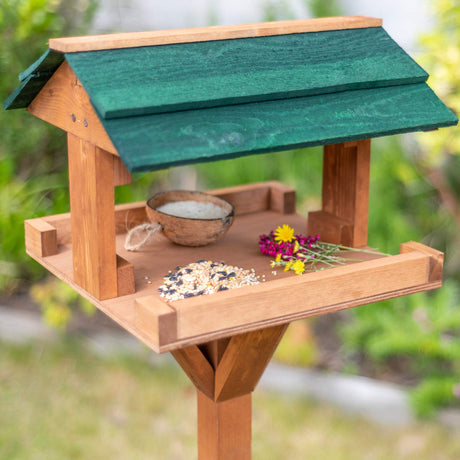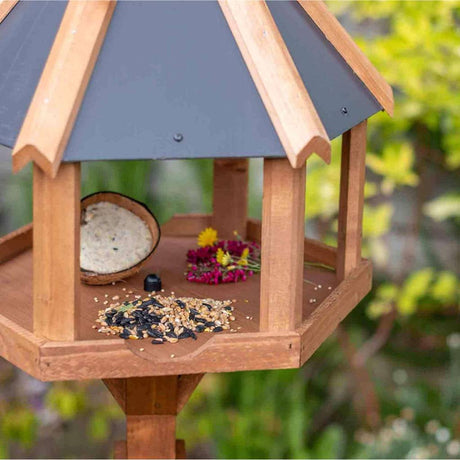You don't need to have a garden to have a bird table. Hanging bird tables or wall-mounted bird tables can work on a balcony or outside your flat window.
For this article, we are going to look at placing a free-standing bird table in the garden.
There are two main areas to consider when placing your bird table:
- What will work best for the birds
- What works best for you
Let's look at the birds' point of view first.
The Right Place for the Birds
To attract birds to your table and keep them coming back, you need to create an environment where they feel safe and relaxed feeding. Here are the issues to consider.
Noise and Activity
Try to place your table in an area of the garden that is not too busy or noisy. Keep it away from paths and the kids' trampoline.
Though birds will happily feed if you are sitting quietly nearby, they won't be comfortable in an area with a lot of noise or human movement.
Windows
Flying into windows can easily injure or kill small birds. The danger with bird tables is that the birds may collide with a window when they take off from the table, especially if they have been spooked by noise or a potential predator.
Strangely, the safest place to put a bird table to avoid window crashes would be very close to the window, within 3 feet. This way, a bird taking off from the table won't have built up enough speed to injure itself if it collides with the window.
But failing this, be sure to leave a reasonable distance between your bird table and your windows: at least 10 feet.
Shelter
Most birds prefer to feed in a relatively sheltered spot. They like to be out of wind and rain and not exposed to too much direct sunlight in high summer.
So try to choose a sheltered spot in your garden, but keep the table away from large overhanging trees, as these can offer access and cover for predators.
Jumping Off Point
Just as you might take a look at a restaurant through the window before going in, birds will want to suss out your table before they sit down to dinner.
They will be making sure it looks safe, the food looks tempting, and there are not too many other birds already dining. So, if you can place the table a few feet from a couple of small shrubs or bushes, this will give the birds somewhere to perch and check out the table before arriving.
It also gives them some there to retreat to quickly if a predator shows up.
In the Open
Yes, I know. I just said to put it in a sheltered position - it's all a bit of a balancing act!
Birds like to have a clear view around them as they eat. This allows them to keep an eye out for any potential predators.
Try to avoid placing your table too near to an overhanging tree, fence or wall. These might be used as a jumping-off point for cats or squirrels or birds of prey.

Also, birds need to be able to see your table to use it. So keeping it in a reasonably open position helps here, too.
Give Us Some Space!
If your bird-feeding efforts are successful, you may find yourself with many birds of many different species visiting your garden each day.
If you have a bird table, hanging feeders and ground feeder try to space them out a little in your garden, This will allow your different feathered visitors to respect one another's personal space.
Elevation
Your bird table should be raised to the correct height. Many of the birds who will be using it feed on the fruits and seeds of bushes, shrubs and other plants. So, they are used to a feeding position 4 to 6 feet from the ground. This height also offers useful protection from cats and other earthbound predators.
The Right Place for You
You are the person who will be looking after the table: adding food, cleaning, and maintaining. And most importantly, you are the person who is hoping to get enjoyment from watching the birds feed. So the position of the table needs to be right for you.
Can You See it?
When you position your bird table, check that you have a good view of it. Go into the house, sit in your favourite chair, and stand at the kitchen sink. Can you see the table? The height of the table comes into play here too. If the table is too high, you may not see it easily from a chair in the house.

Can you see it from where you sit in the garden? During the fine spring weather we had in lockdown, we spent hours in the mornings sitting in the garden drinking coffee and watching the action on the bird table. If you can get your table far enough away from the birds that you don't disturb them and near enough so that you can see them, you've cracked it!
Will It Stay Upright?
There are few things more irritating than a bird table that constantly topples over in the tiniest puff of wind.
Check that the ground is level where you plan to place your table. I mean really level. Use a spirit level. You are dealing with a tall, thin object here, the slightest slope or unevenness in the ground can cause it to topple.

Level out the ground if you need to.
Again, for your convenience, it is best to choose a sheltered spot if you can, away from any windy areas of your garden.
Invest in a set of anchor pegs for extra security.
Will It Be Easy for You To Look After?
Height is a big issue here, too. You will be putting out food daily and cleaning the table once a week or so. No good choosing something enormous if you, like me, are a little person and will struggle to reach the table comfortably.
A sheltered spot will be a plus for your convenience, too. Remember you will be tending to the table 365 days of the year in all weather. On a January morning, you will appreciate a bit of protection from the elements as much as the birds do.

Thinking about those January mornings again, how near is the table to the house and your food store? The further I have to go to feed the birds on a snowy morning or when it's pouring rain, the more likely I am to think about skipping feeding duty. And these are precisely the times when the birds need us the most.
Minimise Mess
Although bird tables are great to look at in your garden, they do cause a mess.
The seed will end up on the floor; this will cause all sorts of random grasses to grow around the base of the table. There will be feathers and the inevitable bird poop. I am sure you will clean up regularly. But you don't want the mess to be irritating you every time you look at the table.
So maybe think twice before you place your bird table in the middle of your croquet lawn Or any other area of beautifully manicured grass.
Your bird table will be most at home in a slightly wilder, more natural area of your garden if you have one.
Conclusion: Trial and Error
Getting the positioning of a bird table right for you AND the birds is no easy matter. but when you get it right, you will be rewarded with a daily display that you can enjoy all year round.
Take your time! Think about where to put the table so that it will meet the needs of our feathered friends.
Then, take some time to look at how it will work in that position from your point of view: can you see it? Will it stay standing up? Is it easy for you to look after?
On the day you place your table be prepared to experiment: move it around, look at it from different angles.
Then when you think you have chosen the right place, it's important to leave it be for at least a couple of weeks.
You need to give the birds a chance to find the table and feel comfortable with it. If you keep moving, this isn't going to happen.
And once you have your bird table in perfect position, sit back, relax and enjoy the show!
We hope you have enjoyed this article and found it useful. If you. If you have questions or suggestions, we would love to hear them. Leave us a comment below.
And for more reading, check out our bird blog here.








